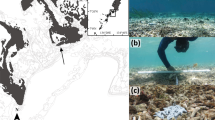Summary
Experiments conducted at US Palmer Station, 1980 on antarctic krill, Euphausia superba, attempted 1) to quantify and describe behavioral features of ingestion, food clearance and egestion, and 2) to test the hypotheses that feeding and swarming are mutually exclusive events, and that feeding is a cyclical, diel phenomenon. Ingestion was quantified in a large flow-through aquarium. Food clearance and egestion were estimated visually and fluorometrically in E. superba individually kept in one liter jars. Ingestion was directly proportional to chlorophyll concentration (0.65–11.5 μgChl/l) and did not change significantly as a function of krill density (200–9000 krill/m3). Ingestion and egestion did not show significant diel trends or mean day-night differences in a 16 h light-8 h dark cycle. Our results suggested that feeding may occur in nature: at swarm densities, within a wide range of phytoplankton concentrations, and may be sustained throughout the diel cycle. We propose that feeding and swarming are co-occurring events. The theoretical basis at the individual and group levels, and its implications, are briefly discussed.
Similar content being viewed by others
References
Barkley E (1940) Nahrung und Filterapparat des Walkrebschens Euphausia superba Dana. Z Fisch 1:66–156
Berkes F (1975) Some aspects of feeding mechanisms of euphausiid crustaceans. Crustaceana 29:266–270
El-Sayed SZ (1967) On the productivity of the southwest Atlantic Ocean and the waters west of the Antarctic Peninsula. In: Llano GA, Schmitt WL (eds) Antarctic research ser 11. Biology of the Antarctic seas III. American Geophysical Union, Washington DC, pp 15–47
Gauld DT (1951) The grazing rate of planktonic copepods. J Mar Biol Assoc UK 29:695–706
Hardy AC, Gunther RE (1935) The plankton of the South Georigia whaling grounds and adjacent waters, 1926–1927. Discovery Rep 11:1–456
Holm-Hansen O, Lorenzen GG, Holmes RW, Strickland JDH (1965) Fluorometric determination of chlorophyll. J Cons Cons Int Explor Mer 30:3–15
Holm-Hansen O, El-Sayed SZ, Franceschini GA, Cuhel GA, Cuhel RL (1977) Primary production and the factor controlling phytoplankton growth in the Southern Ocean. In: Llano GA (ed) Adaptations within Antarctic ecosystems. Gulf Publishing Company, Texas, pp 11–73
Huntley M (1981) Non selective, nonsaturated feeding by three calanid copepod species in the Labrador Sea. Limnol Oceanogr 26:831–842
Kalinowski J (1978) Vertical migration of krill in the region of South Georgia, February–March 1976. Pol Arch Hydrobiol 25:573–583
Kato M, Murano M, Segawa S (1979) Estimation of the Filtering rate of the Antarctic krill under laboratory conditions. Trans Tokyo Univ Fish 3:107–112
Kawamura A (1981) Food habits of Euphausia superba and the diatom community. BIOMASS 2:65–68
Marr J (1962) The natural history and geography of the antarctic krill (Euphausia superba Dana). Discovery Rep 32:33–464
Mauchline J (1979) Antarctic krill biology. BIOMASS Rep Ser 10:1–52
McWhinnie MA, Denys CJ (1978a) Biological studies of antarctic krill, austral summer 1977–1978. Antarctic J US 13:133–135
McWhinnie MA, Denys CJ (1978b) Antarctic marine living resources with special reference to krill, Euphausia superba: assessment of adequacy of present knowledge. Report to USNSF 1978, 209 pp
Mezykowski T, Rakusa-Suszczewski S (1979) The circadian rhythms in Euphausia superba Dana and its carbohydrate metabolism. Meeresforschung 27:124–129
Nemoto T (1967) Feeding pattern of euphausiids and differentiation in their body character. Inf Bull Planktol Jpn (Commemoration number of Dr. Y. Matsue) 157–171
Nemoto T, Doi T, Nasu K (1981) Biological characteristics of krill caught in the southern ocean. BIOMASS 2:47–63
Pavlov VYa (1969) The feeding of krill and some features of its behaviour. Trudy VNIRO 66:207–222 (issued as MAFF Transl ns 94)
Rigler FH (1971) Feeding rates. Zooplankton. In: Edmonson WT, Winberg GG (eds) A manual on methods for the assessment of secondary productivity in fresh waters. Blackwell, Edinburgh, pp 228–256
Steinwascher K (1978) Interference and exploitation competition among tadpoles of Rana utricularia. Ecology 59:1039–1046
Sushchenya LM (1970) Food rations, metabolism and growth of crustacean. In: Steele JH (ed) Marine food chains. Oliver and Boyd, Edinburgh, pp 127–141
Tate MW, Clelland RC (1959) Non parametric and shortcut statistics. Interstate Printers and Publishers Inc, Illinois
Test FH, McCann RG (1976) Foraging behavior of Bufo americanus tadpoles in response to high densities of micro-organisms. Copeia 576–578
Author information
Authors and Affiliations
Additional information
In memory of Mary Alice McWhinnie (1922–1980)
This research was supported by the University of Chile, National Science Foundation and Chilean Antarctic Institute
Rights and permissions
About this article
Cite this article
Antezana, T., Ray, K. & Melo, C. Trophic behavior of Euphausia superba Dana in laboratory conditions. Polar Biol 1, 77–82 (1982). https://doi.org/10.1007/BF00263803
Received:
Accepted:
Issue Date:
DOI: https://doi.org/10.1007/BF00263803




